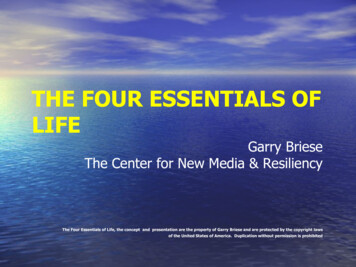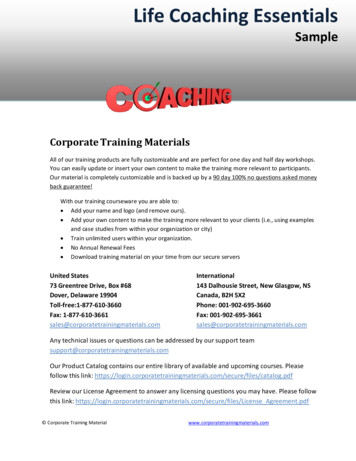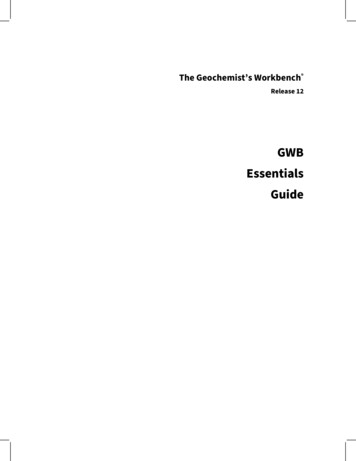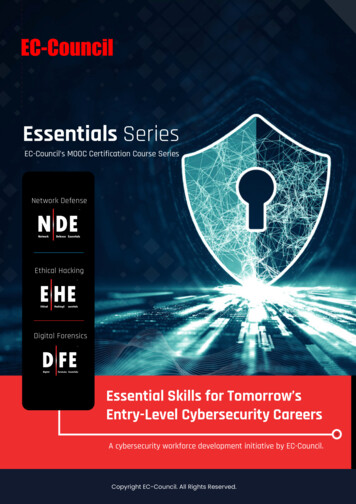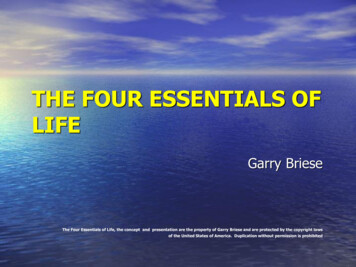
Transcription
THE FOUR ESSENTIALS OFLIFEGarry BrieseThe Four Essentials of Life, the concept and presentation are the property of Garry Briese and are protected by the copyright lawsof the United States of America. Duplication without permission is prohibited
Challenges for EmergencyManagement How do people actually react & why? Accept what is, not what we want to believe What we plan, and what people actually do areincreasingly different Design systems to support what people actuallydo
Economics & EmergencyManagement Most vulnerable populationsLiving below poverty levelNo credit cardsPaycheck to paycheckNo disposable income Impact on emergency management––––Self-definition of special needs populationsHuge increase of assisted evacuationCost of personal preparednessFuel, food & shelter demands increased
The Four Essentials Of LifeFrom the human perspective CommunicationsTransportationPowerWater
Maslow’s Hierarchy of Needs
Human Response Most people take shortcuts based on experience,emotion & various biases They will act in what they believe is in their bestinterest Parents overwhelming seek reunification withchildren Efforts to modify these behaviors will notsignificantly influence actions
Mind Boggling Numbers 87% of the US population owns a wirelessdevice 90% of Americans are within 3 feet of theirmobile device 24 hours a day Twitter – more than 7 million users Facebook – more than 300 million users YouTube – 65,000 new videos each day 35% of US households basically wireless
Communications Billions of cell phones /communications devices Public expectation is to communicate 24/7 An imperative to communicate Nothing can be done to reduce this imperative Public expectation is for emergency services tohave same capabilities
Communications Public to public communications underway beforeauthorities have arrived on the scene Cell calls, text messages, photos, video, and audio Viral communications
The Media Role CNN I-Reports pull communications from thepublic Local TV Stations:encourages viewersubmissions
What Does This Mean forEmergency Management? Meet public expectations for 24/7communications Embrace & use social networking systemsfollowing lead of news media Provide timely, accurate information by all meanspossible Higher priority for restoring cell phone service
Transportation Normal rush hoursdemonstrate inadequacy ofhighway system Current pace ofimprovement is notenough to keep up witheven slow growth
Transportation Get to my family, Get away from danger Drastic increase in “special needs” populations Non-self evacuating populations Who pays?
Transportation Only 11 of 37 urban areasreceived passing evacuationgrades Evacuation of urban areas isthe most critical unresolvedissue in emergencymanagement today Multi-agency approach State-level or multi-state
New Technologies Real-time integration of information GPS Tracking of cell phone density Statewide public warning systems Integration of multiple technologies with GIS Two-way communications
What Does This Mean forEmergency Services? Recognize economic challenges & who pays Urban evacuation needs higher priority Continued focus on integration of technologies Use of easy-to-understand visuals & process Practice .not likely .simulations
Power “Everything” we do is based on havingavailability of power More dependency on batteries than everbefore Without power, our society quickly looses keyfunctions and social structure is challenged We are more dependent than independent
2003 Blackout 9,300 square miles8 states, 2 provinces50 million peopleNo trains, no planes, nocell phones, nocomputersWater systems shutdown
Loss of Power 2006, Queens, NYC -- 100,000 people withoutpower for nine days 2008, Florida, 2.5 million
Power Concerns Intentional intrusion of electrical grid Most fire, police, government buildings do nothave full building auxiliary power Power companies selling home generators Gasoline, food, water?
What Does This Mean forEmergency Services? Battery dependent society is not resilient Gasoline availability is critical for public resiliency Key government facilities must have backuppower Lessons learned from massive powerinterruptions need to be integrated in plans
Water To sustain life– 5 weeks without food– 5 days without water Potable water is one of the first post-disaster“requirements” for both responders and survivors
Potable Water Presents a majorlogisticalchallenge Complicatedsupply chain ExpensiveAbout 2 quarts needed per person, per day
Movement of Water Katrina/Rita 13 mill gallons More than 100million Gustav/Ike 10 mill gallons 8 pounds/gallon
Your Post-Disaster WaterResource
Alternatives for Water Purification Lifestraw: 3 yearshelf life, 184gallons or 1 yearof use PUR Purifier ofWater: costs 0.10for a family of fivefor one day
What Does This Mean forEmergency Management? Use local sourcing. Public education to use water heaters Simplify supply chain Use alternatives for purification
EstablishPoints of Light Every fire station Every police station Major public buildings Whole-building generatorsPre-drilled water wellsPortable cell towersCached equipment and supplies
Looking to the Future Base actions on research on human response Accept what is, not what we want to believe Design systems to support what people actuallydo
It’s not that we cannot solve the problem,sometimes we cannot even see theproblem
Garry Briesegbriese@brieseandassociates.comThe Four Essentials of Life, the concept and presentation are the property of Garry Briese and are protected by the copyright laws of the United States of America.Duplication without permission is prohibited
Garry Briese The Four Essentials of Life, the concept and presentation are the property of Garry Briese and are protected by the copyright laws of the United States of America. Duplication without permission is prohibited. Challenges for

